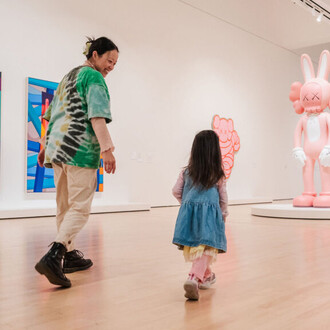Clothing exists to cover our bodies, but it can also uncover latent histories and personal narratives. To what extent does our choice of dress suggest individual taste or reflect influences from our surroundings? The variety of costumes displayed in this exhibition attests to the diversity of Jewish communities across centuries and around the globe. In many cases, the clothes worn by Jews were similar or even identical to those worn by non-Jewish neighbors, although at times special features distinguished them from the dominant culture.
This exhibition invites us to consider the history and language of Jewish clothing in all its complexity, from cultural dress codes to modes of self-expression. Through many sartorial symbols and signifiers, these items disclose information about gender, age, geography, background, and custom, while simultaneously leaving some meanings fluid or encoded.
Regardless of origin, each ensemble tells a story—the story of its creator or wearer, of the community to which it belonged, or of its voyage across multiple generations, families, and channels of transit. These garments, dating primarily from the nineteenth and early twentieth centuries, are drawn from the Israel Museum, Jerusalem, the repository of the most comprehensive collection of Jewish costume in the world. Its holdings provide a unique testimony to bygone communities, to forms of dress and craft that no longer exist, and to a sense of beauty that still has the power to enthrall.
The extraordinary range of textile designs and clothing in the exhibition illuminates the story of how diverse global cultures have thrived, interacted, and inspired each other for centuries. Jewish communities from Afghanistan, Algeria, Denmark, Egypt, Ethiopia, Germany, Georgia, Greece, India, Iran, Iraq, Iraqi Kurdistan, Israel, Italy, Libya, Morocco, Poland, Romania, Tunisia, Turkey, the United States, Uzbekistan, and Yemen are represented with the majority of pieces originating from North Africa, the Middle East, and Central Asia. Approximately 65 items of clothing will be on display, representing excellent examples from the much larger collection of Jewish diasporic clothing held by the Israel Museum. Foregrounding color, texture, function, artistry, and craftsmanship, Veiled Meanings offers an incisive and compelling examination of diversity and migration through the lens of fashion.
Veiled Meanings: Fashioning Jewish Dress, from the Collection of The Israel Museum, Jerusalem will focus on how clothes balance the personal with the social, how dress traditions distinguish different Jewish communities according to their respective local dress codes, and how they portray Jewish and secular affiliations within larger societal and global contexts. Historical, geographic, social, and symbolic interpretations will be included within the context of four thematic sections: Exposing the Unseen; Through the Veil; Clothing that Remembers; and Interweaving Cultures.
This touring version of The Israel Museum’s original exhibition Dress Codes was developed for The Contemporary Jewish Museum and The Jewish Museum in New York, which are the only two venues to exhibit Veiled Meanings in the United States to date.
















